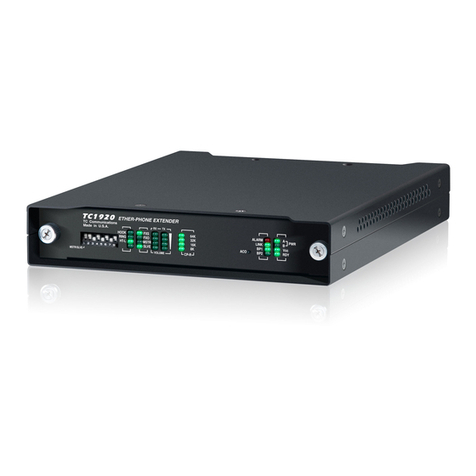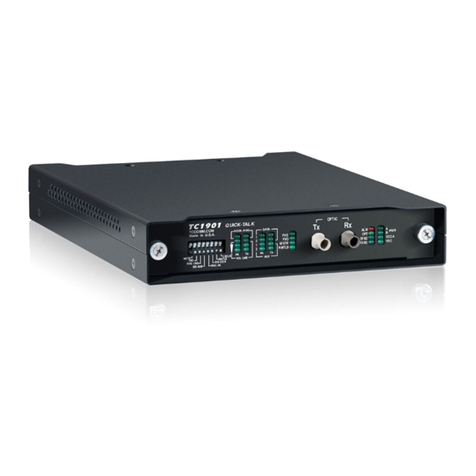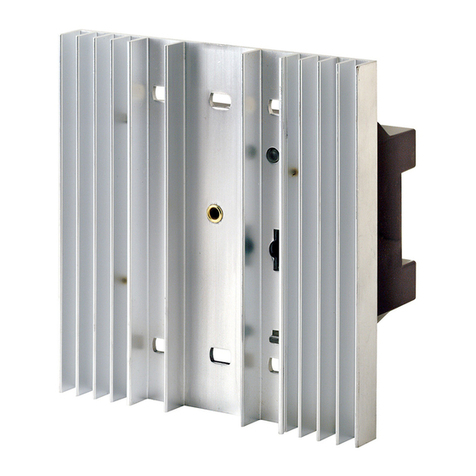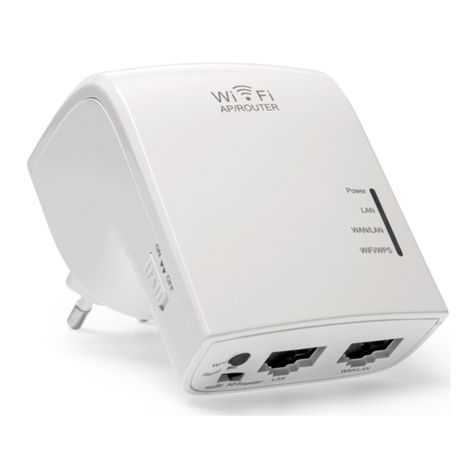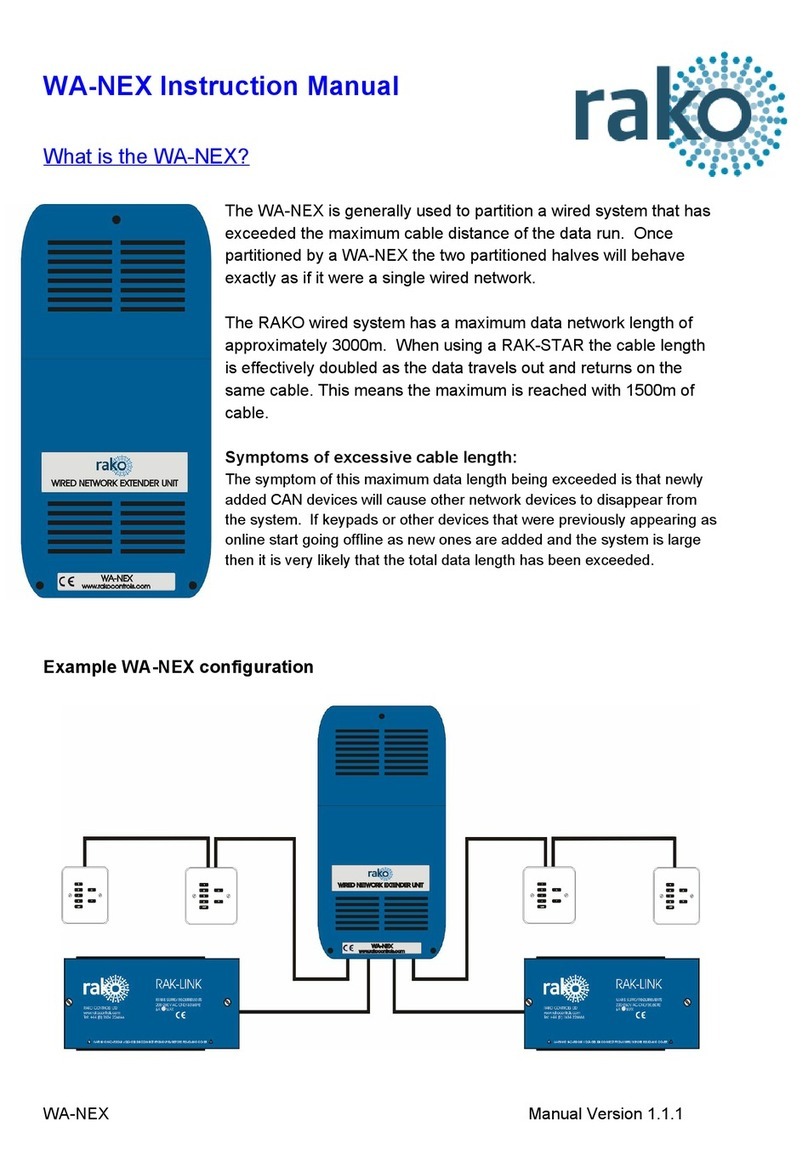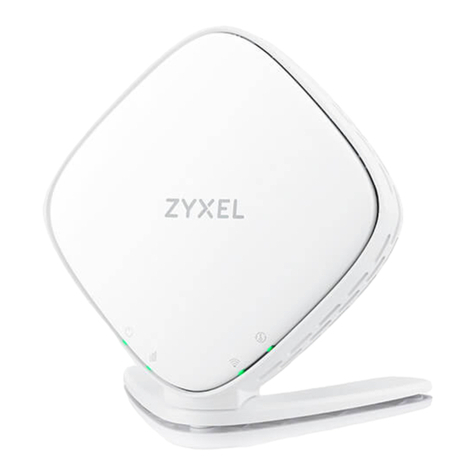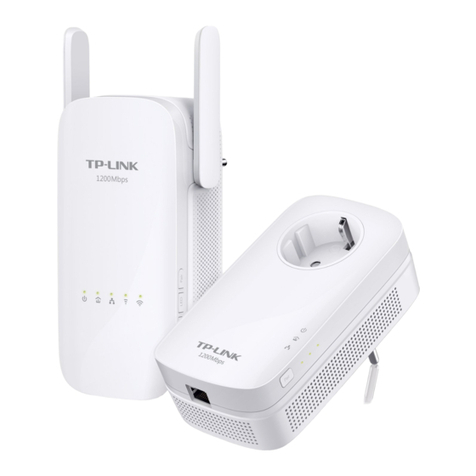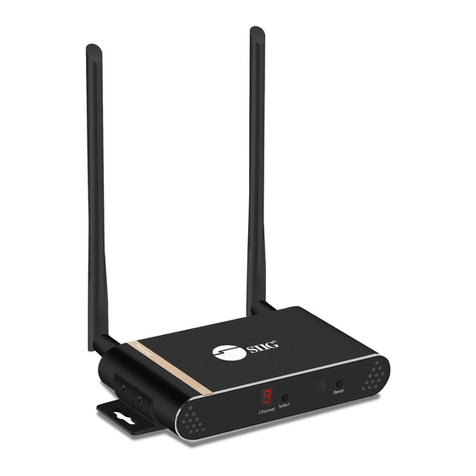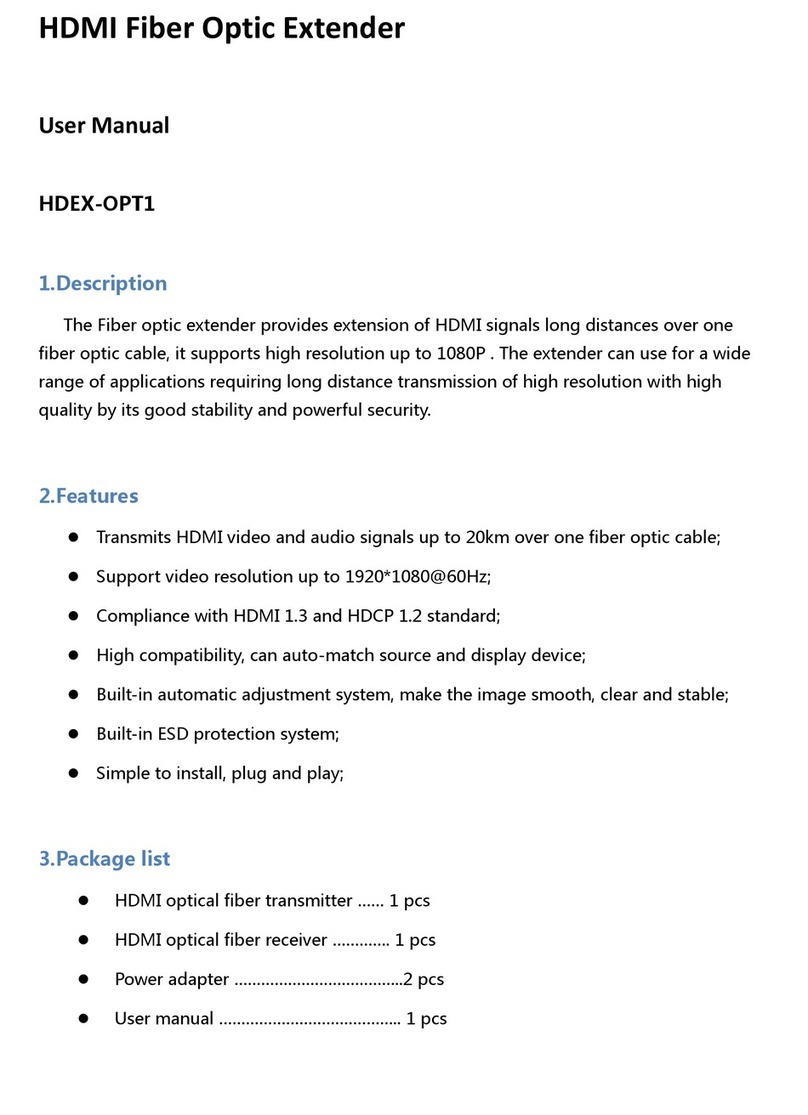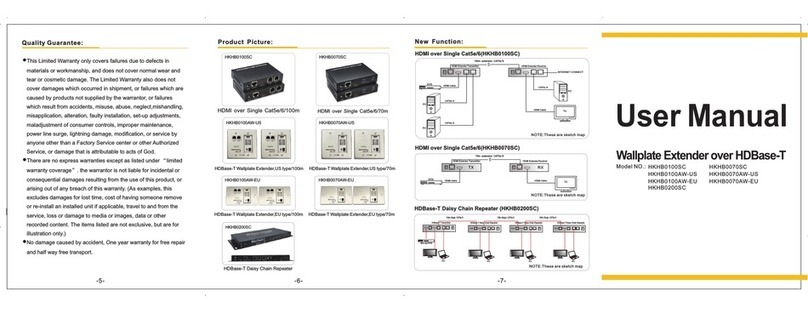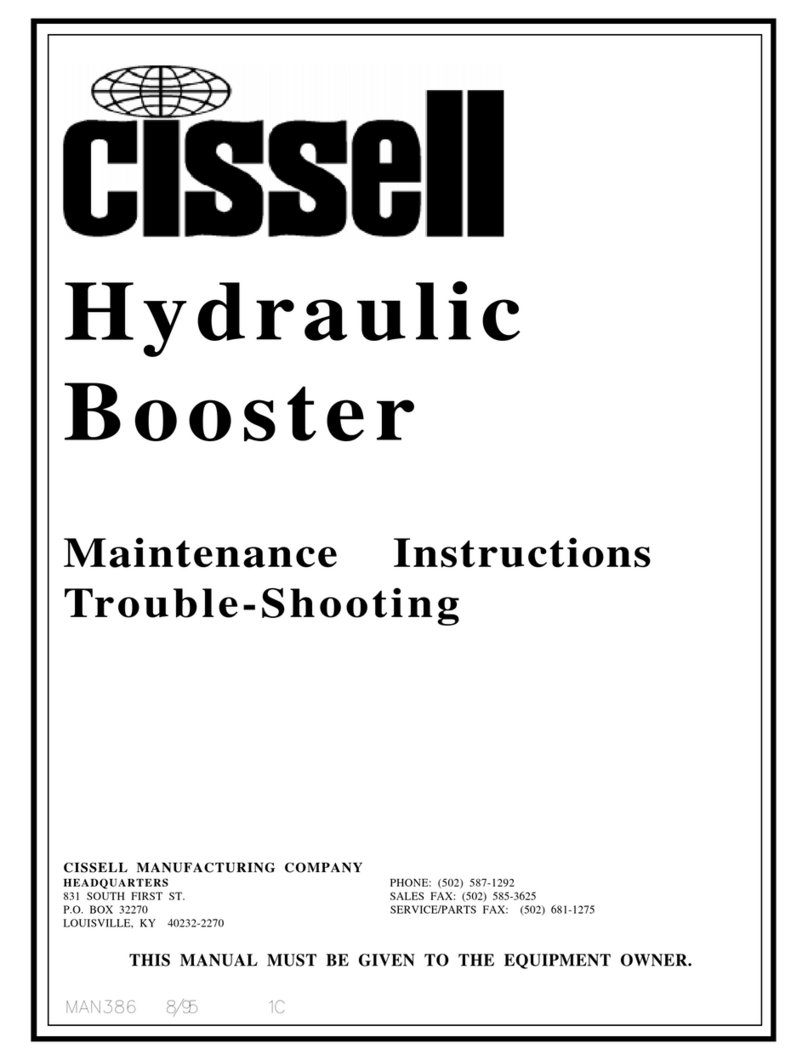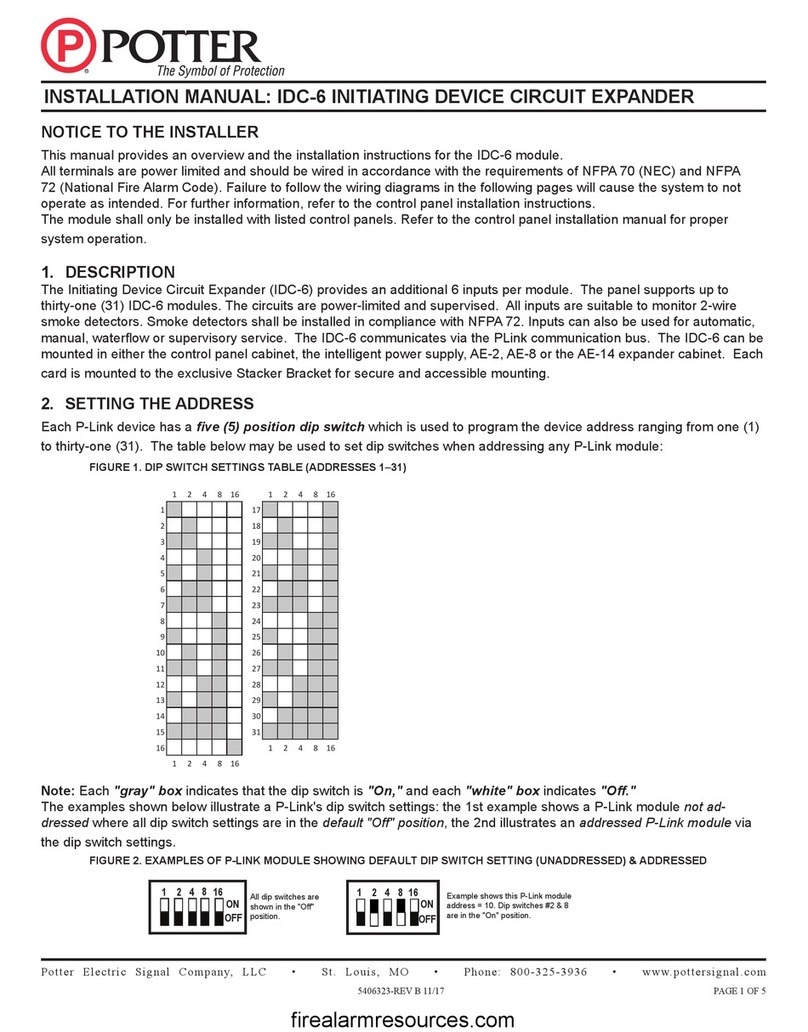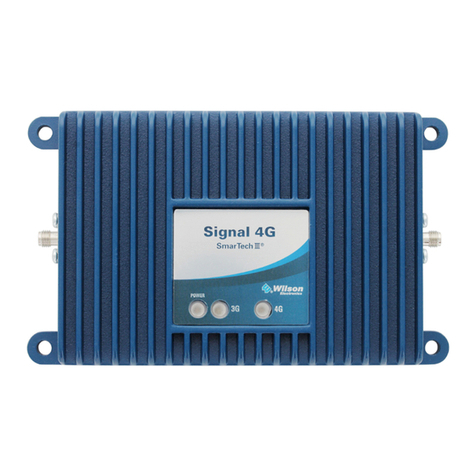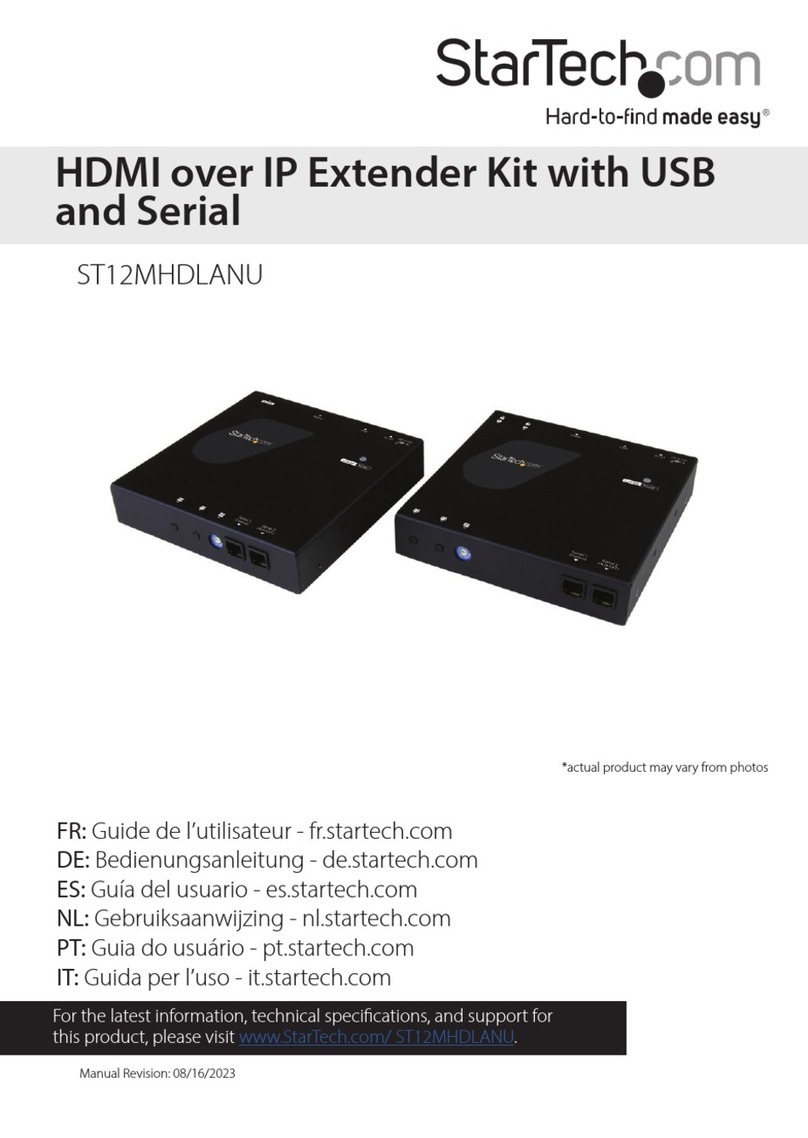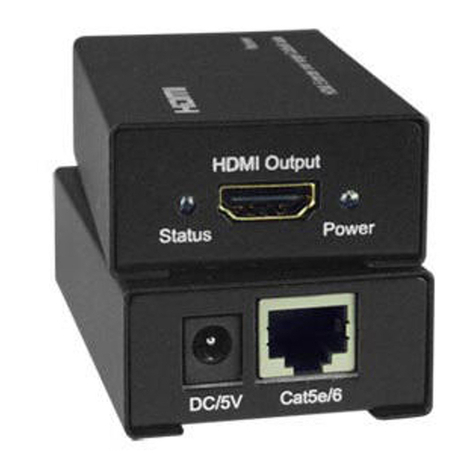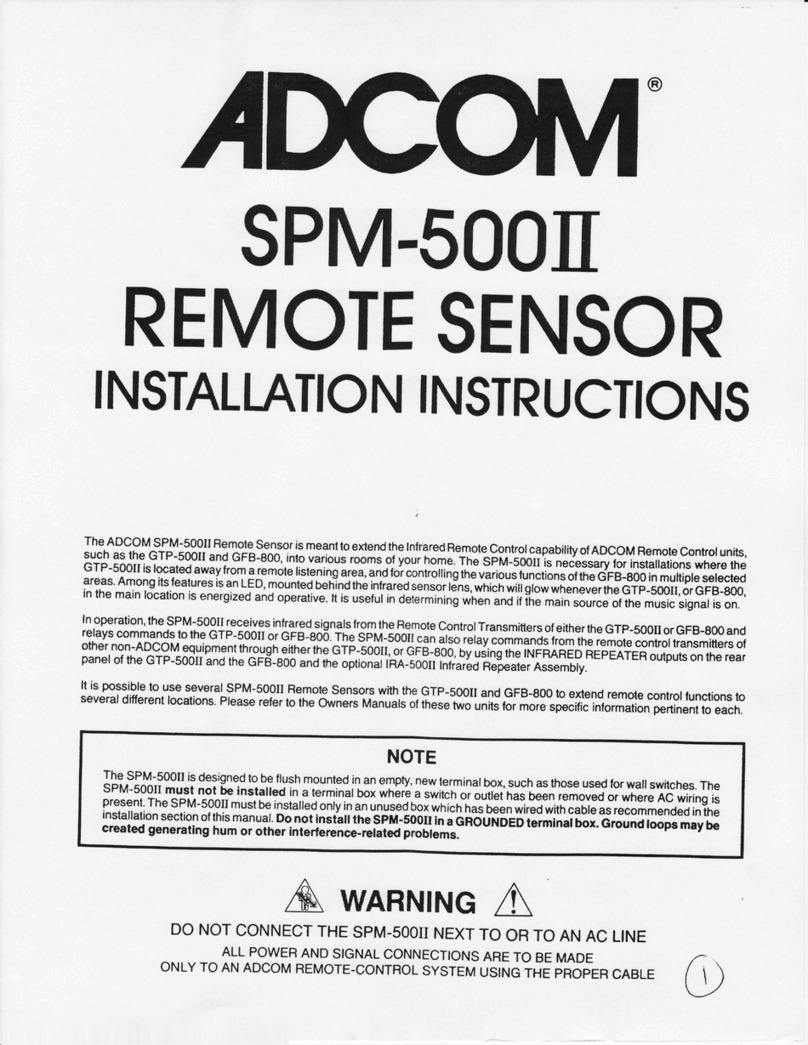TC Communications TC1903 User manual

Notice!
Although every effort has been made to insure that this manual is current
and accurate as of date of publication, no guarantee is given or implied
that this document is error free or accurate with regard to any specifica-
tion. TC Communications, Inc. reserves the right to change or modify
the contents of this manual at any time without prior notification.
© COPYRIGHT 1992-2015. ALL RIGHTS RESERVED.
TC Communications, Inc. 17881 Cartwright Road - Irvine, CA 92614
Tel: (949) 852-1972 Fax: (949) 852-1948 Web Site: www.tccomm.com Email: info@tccomm.com
MNL-19030-01-19

- 2 -
MNL-19030-01-19

- 3 -
MNL-19030-01-19
Features
Description
The TC1903 "Quick Talk" is designed specifically to extend a regular analog phone line from a PBX to remote
location via optic cable. The voice picked up by a handset's mouth piece (connected to the TC1903) is
digitized. Because the TC1903 digitizes the analog signals (PCM), voice quality does not degrade over
extended distances.
The functions of the TC1903 fiber optic extender are for one channel phone or one channel analog signal for
2 or 4 wire.
The analog interface is for FSK (frequency shift key) applications. The analog interface has 600 ohm
isolation audio transformer. The analog voltage can be 0 to 3 Vpp.
The TC1903 units require to be configured as FXS, FXO, or Analog at the factory according to the customer's
application needs. The front DIP switch is used to set the unit as FXS or FXO (this will generally be set at
the factory), and one rear panel RJ-11 port is dedicated for FXS, FXO or 2/4 Analog 600 Ohm signal.
The TC1903s can be used to set up a phone line extension FXO to FXS or a phone hot link FXS to FXS setup.
The hot link will require both units to be ordered with FXS interface modules.
One of the two units has to be set as a Master with the front DIP switch "MSTR" in the "down" position.
The other unit must be a "Slave" unit with front DIP switch "MSTR" set to the "up" position.
When both units are set as FXS, the front DIP switch "RING CAD" can be set to ring the other party with
a "candence" instead of a straight ring.
Application examples are on page 9 for FXO to FXS or FXS to FXS setups.
The LEDs on the front panel show the power status, ringing signal, Master status, FXS/FXO status, voice
volume picked up by local phone's mouth piece and the voice volume received from remote peer. TC1903
has a built-in dry contact relay to provide external alarm. The standard power supply is 12VDC at 500mA
max. Power options include 24VDC, -48VDC, 125VDC or AC to DC power adapter which can be ordered
for a 115VAC to 230VAC power supply (use of factory adapters are recommended).

- 4 -
MNL-19030-01-19

- 5 -
MNL-19030-01-19

- 6 -
MNL-19030-01-19

- 7 -
MNL-19030-01-19
POWER A: When lit, a good power source is present at power jack A (rear panel).
POWER B: When lit, a good power source is present at power jack B (rear panel).
VccA: +5V Voltage indicator. This LED should light whenever power is connected to the
unit. It indicates the correct operating voltage is being derived from the power source.
VDC: Not Used.
ALM: Alarm indicator. When lit on Red, there is problem with the incoming optical
signal.
OPT: "On" lit all the time, it indicates that the transmitter is ready to transmit optical power.
SYNC: When lit, it indicates valid optic signal is received. When flashing, it indicates an
invalid optic signal is received. This can happen when the optic receiver is overdrived or
the wrong optic signal is received.
RSNC: Remote Sync; When lit, it indicates "SYNC" LED status at the remote unit's front panel.
When Off, either the remote unit didn't receive good optic signal or local unit didn't
receive optic signal.
FXS: When lit, it indicates the RJ-11 port is set for FXS.
When flashing, it indicates a problem with the FXS module. If the problem persists, call the
Technical Support Department at TC Communications, Inc know about the problem at (949) 852-
1973.
FXO: When lit, it indicates the RJ-11 port is set for FXO.
MSTR: When lit, it indicates the unit is set as the "Master" of the link.
RMTLB: When lit, it indicates the unit's "RMTLB" switch is on. (future release)
RING: When lit or flashing, it indicates the following:
1) When set to FXS, a ring signal is received from the remote unit.
2) When set to FXO, a ring signal is received from the phone line.
HOOK: When lit, it indicates the following:
1) When set to FXS, the local phone is off hook.
2) When set to FXO, the remote unit is off hook.
NOTE: The rest of the LEDs will be for future releases.

- 8 -
MNL-19030-01-19
This RJ-11 is to be used for the connection of FXS, FXO, or Analog depending on the configuration ordered:
For FXS - Connect to a regular (conventional) 2-wire telephone set. If a hotlink phone line is desired, then
both TC1903s should connect to this "FXS" connector.
For FXO - Use regular phone wire to connect the TC1903 to a dial up phone network such as phone line
from Telco or PBX phone line.
For Analog - When using the analog interface, use this RJ-11 jack to connect your 2 or 4 wire analog signal.
Refer to the pin assignments on page 10.
Note: The 2 or 4 wire analog 600 ohm interface module will depend on which type the customer will
order for their application.
The Dry Contact Relay is normally in the “Open” position. The following conditions will activate the dry
contact relay to "close" status:
1. When there is a Major Alarm (Optic signal is lost). This function can be disabled by setting the
front panel SW1-4 to the "down" position.
The user can use the Dry Contact Relay for an additional function by enabling SW4_3 to the On position
(internal switch#2) on the FXS side unit only. This feature allows the Dry Contact Relay to close and open
as the telephone set rings. The user can use it to connect an additional external device so that the user can
monitor the ringing when they are away from their phone. By using this function, all the LEDs will behave
normal.
PWR
A
PWR
B
+ - + -

- 9 -
MNL-19030-01-19
This application is to extend a phone line via fiber optic cable. Follow the connections shown in the following
diagram. Connect two TC1903s via fiber optic cable, from default factory, one unit will be set as FXO and
the other as FXS. Connect a regular dial-up phone line to RJ-11 connector of the "FXO" unit and connect
a telephone set to RJ-11 connector of the "FXS" unit. To establish a call, the users at the remote end (FXS
side) can pickup the phone and dial out to outside phone network just like regular telephone line extended.
Make sure you set one of the units as a "Master" and the other as a "Slave".
By connecting two TC1903s together using two regular telephone sets, the users at both sides of the fiber
link can have a hotlink phone line setup. When one user lifts up the handset, the remote side phone will start
to ring. When remote side user picks up the handset, the phone stops to ring and the conversation begins.
When conversation is over any user can replace the handset to hook to terminate the phone link. If either
party places the handset to hook and the other does not hang up, the phone on hook will continue to ring.
NOTE 1: For this application, both of the TC1903 units will be required to be ordered as FXS units.
NOTE 2: You may experience some clicking noise, this is normal until the remote side picks up the handset.

- 10 -
MNL-19030-01-19
Figure 5 shows how the TC1903 connects to the phone or PBX as in Figure 3 and 4. TC1903's RJ-11 Jack
use the middle two pins to connect to telephone or PBX's Tip and Ring.
For analog audio signals:
Pin 5 is the transmit TIP & pin2 is the transmit RING.
Pin 4 is the receive TIP & pin 3 is the receive RING.
Note: When using the Analog interface, both TC1903 units must be configured as FXO units. Typically, this
configuration will be done by the factory depending on the customer's application. The front panel DIP switches
#2 will be set to the down "On" position.

- 11 -
MNL-19030-01-19
Before unpacking any equipment, inspect all shipping containers for evidence of external damage caused
during transportation. The equipment should also be inspected for damage after it is removed from the
container(s). Claims concerning shipping damage should be made directly to the pertinent shipping agencies.
Any discrepancies should be reported immediately to TC Communications' Customer Service Department.
The TC1903 should be located in an area that provides adequate light, work space, and ventilation. Avoid
locating it next to any equipment that may produce electrical interference or strong magnetic fields, such as
elevator shafts or heavy duty power supplies. As with any electronic equipment, keep the unit from excessive
moisture, heat, vibration, and freezing temperatures.
Each TC1903 unit is powered via a rear panel's terminal block connector. There are two pairs
of terminal block connectors ("PWR A" and "PWR B") for power redundancy, the power
LEDs on the front panel will light according to which power jack(s) is/are connected. The
power is 12VDC @500mA, (24VDC, -48VDC, 125VDC and AC 115VAC to 230VAC are
optional).
The RJ-11 connector uses the middle two pins for Tip and Ring, see page 8 for pin assignments.
DIP switch #1 must be set opposite on the local and remote units, one of the units must be a Master and the
other a Slave. DIP switch #2, will be generally set by the factory according to what setup is ordered for FXO
to FXS (line extension) or FXS to FXS (hotlink) or FXO to FXO (Analog). DIP switch #3, use to change the
ring sound. DIP switch #4, use to disable the alarm. DIP switch #5, use to force "off hook" condition (for
testing only). DIP switches #6, 7, and 8 are for future releases (not used).
When power is first turned on, all the LEDs should be flashing for one second. This allows the user to be
sure all the LEDs are in working condition.
With fiber optic cable connected between two units, after one minute, the "alarm" LED should be Off, "PWR
A" or "PWR B" or both will be On, "VCCA," "OPT," " SYNC," and "RSNC" will be On, one of "FXS" or "FXO"
LEDs should be on to indicate FXO or FXS setup, and the "MSTR" LED should be lit on only one of the units.
The flashing green LEDs will turn to solid when abnormal conditions are removed and the red LED (alarm)
will be off.

- 12 -
MNL-19030-01-19
1. Apply the power by plugging the power plug into any power jack on the rear panel. The power source
can be from a power adapter or from a power card (installed either on the left or right side of the rack).
2. The "PWR A" or "PWR B" LED on the front panel of the card will light according to which power jack
(A or B) is connected. Both LEDs will light when power redundancy is utilized.
3. The "Vcc" LED should be lit, indicating an adequate operating voltage is being derived from the power
source.
4. Make sure front panel DIP switches are set correctly according to your application, refer to page 6.
5. Connect the units according to your setup, refer to page 9. If extending a phone line, make sure the RJ-
11 cable is connected correctly on the RJ-11 connector on the rear panel for FXO/FXS. If using a "hot
link" setup, both units should be factory set for "FXS."
6. Once fiber optical cable(s) are connected, communication is setup between TC1903 peers, the alarm
"ALM" LED will be Off, the green "SYNC," and "RSYNC" LEDs should be solidly lit to indicate good
optic signal is received.
7. Lift up local phone's handset and observe the remote TC1903's "RING" LEDs start to flash.
8. Once the remote phone rings, the remote user can answer the call by picking up the remote handset.
9. When both parties communicate, the front panel "VOLUME" LEDs should indicate the transmit and
receive volume.
10. When one of the parties replace the handset to hook to terminate the communication, both units will turn
into "idle" state.
Note: The TC1903 FXS configured unit(s) will ring the phone channel during initialization, and the
phone set connected on the FXS channel should ring 10 seconds after power up.
Lightning/Surge Warning Note:
If copper cable(s) connected to TC1903 unit(s) are located outside buildings or enclosures (even at
minimal distances), TC1903 units may be damaged by lightning and/or electrical power surges.
Adding protective devices (surge suppressors/lighting protectors) to each copper cable that is exposed
to potential lightning strikes or power surges is highly recommended. Please be aware that adding such
protective devices can't guarantee 100 percent protection for connected electronic equipment. You
should contact a professional lightning/surge protection consultant for specific questions regarding your
application.

- 13 -
MNL-19030-01-19
The RJ-11 cable connectors are frequently the source of various problems. Check out the connectors, cable,
and pin connections first. Once installation of the TC1903s is complete, it is a good idea to perform a bench
test to verify that the TC1903s are working properly.
If no LEDs are lit on the unit, check the DC power supply, terminal block connector plug, and/or power
source. If the problem persists, contact the Technical Support Department at TC Communications, Inc.
When there is an alarm condition, the red alarm "ALM" LED will be lit and the "OPT" & "SYNC" LEDs will
also flash to indicate the optic signal has been lost. The Alarm will also trigger the dry contact relay switch.
Future release.
Future release
Conventionally, fiber optic cable with yellow-colored insulation is used for single mode applications; gray or
orange-colored insulated cable is for multimode use. If multimode cable is used in a single mode application,
the test results could be erroneous and confusing.
The fiber optic link and/or the connectors are frequently the source of communication problems. If problems
are present, check the optic connectors and the integrity of the link first. Ideally, the link should be calibrated
for total loss after the installation has been completed. This will accomplish two things: (1) it will verify that
the total loss of the link is within the loss budget of the device and (2) it will provide a benchmark for future
testing. For example, a system that has been tested as having 6dB of signal loss when installed should not
suddenly test out as having a loss of 10dB. If this were the case, however, the fiber link or connector would
probably be the source of the problem.

- 14 -
MNL-19030-01-19

- 15 -
MNL-19030-01-19

- 16 -
MNL-19030-01-19
To return a product, you must first obtain a Return Material Authorization number from the Customer
Service Department. If the product’s warranty has expired, you will need to provide a purchase order to
authorize the repair. When returning a product for a suspected failure, please provide a description of the
problem and any results of diagnostic tests that have been conducted.
All products manufactured by TC Communications, Inc. come with a five year (beginning 1-1-02)
warranty. TC Communications, Inc. warrants to the Buyer that all goods sold will perform in accordance
with the applicable data sheets, drawings or written specifications. It also warrants that, at the time of sale,
the goods will be free from defects in material or workmanship. This warranty shall apply for a period of
five years from the date of shipment, unless goods have been subject to misuse, neglect, altered or destroyed
serial number labels, accidents (damages caused in whole or in part to accident, lightning, power surge, floods,
fires, earthquakes, natural disasters, or Acts of God.), improper installation or maintenance, or alteration or
repair by anyone other than Seller or its authorized representative.
Buyer should notify TC Communications, Inc. promptly in writing of any claim based upon warranty, and
TC Communications, Inc., at its option, may first inspect such goods at the premises of the Buyer, or may
give written authorization to Buyer to return the goods to TC Communications, Inc., transportation charges
prepaid, for examination by TC Communications, Inc. Buyer shall bear the risk of loss until all goods
authorized to be returned are delivered to TC Communications, Inc. TC Communications, Inc. shall not be
liable for any inspection, packing or labor costs in connection with the return of goods.
In the event that TC Communications, Inc. breaches its obligation of warranty, the sole and exclusive
remedy of the Buyer is limited to replacement, repair or credit of the purchase price, at TC Communications,
Inc.’s option.
To return a product, you must first obtain a Return Material Authorization (RMA) number and RMA form
from the Customer Service Department. If the product’s warranty has expired, you will need to provide a
purchase order to authorize the repair. When returning a product for a suspected failure, please fill out RMA
form provided with a description of the problem(s) and any results of diagnostic tests that have been
conducted. The shipping expense to TC Communications should be prepaid. The product should be properly
packaged and insured. After the product is repaired, TC Communications will ship the product back to the
shipper at TC's cost to U.S. domestic destinations. (Foreign customers are responsible for all shipping costs,
duties and taxes [both ways]. We will reject any packages with airway bill indicating TC communications
is responsible for Duties and Taxes. To avoid Customs Duties and Taxes, please include proper documents
indicating the product(s) are returned for repair/retest).
1. In no event shall the total liablility of TC Communications, Inc. to purchaser and/or end user for all damages
including but not limited to compensatory, consequential and punitive damages, exceed the total amount paid
to TC Communications, Inc. by purchaser for the goods from which the claim arose, in no event shall TC
Communications, Inc. be responsible for indirect and consequential damages.
Continue on next page.

- 17 -
MNL-19030-01-19
2. In no event shall liability attached to TC Communications, Inc. unless notice in writing is given to TC
Communications, Inc. within ten days of the occurrence of the event giving rise to such claim.
3. TC Communications, Inc. shall not be responsible for delays or non-deliveries directly or indirectly
resulting from or contributed to by foreign or domestic embargoes, seizure, fire, flood, explosion, strike, act
of God, vandalism, insurrection, riot, war, or the adoption or enactment of any law, ordinances, regulation,
or ruling or order or any other cause beyond the control of TC Communications, Inc.
4. TC Communications, Inc. shall not be responsible for loss or damage in transit and any claims for such
loss or damage shall be filed by the purchaser with the carrier.

- 18 -
MNL-19030-01-19
FXO-Foreign Exchange Office.
FXO configuration is required for a plain old telephone service (POTS) to generate a call to the telephone
network.
FXS-Foreign Exchange Station.
FXS configuration is required for a telephone network to generate a call to a plain old telephone set.
Hotlink-direct connected phone line.
PBX-Private Branch Exchange.
A telephone exchange device owned by private entity.
Ringdown-provide ringing signal.
Toll quality voice-voice frequency is restricted within 300Hz to 3.4KHz.
Other TC Communications Extender manuals
